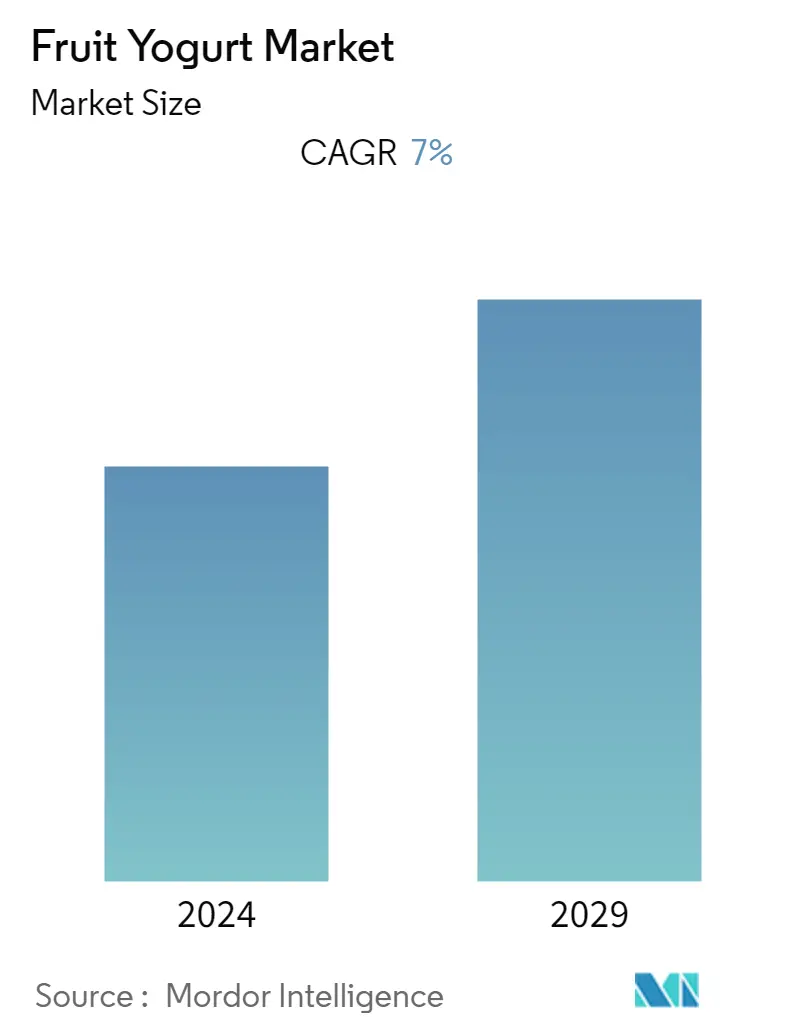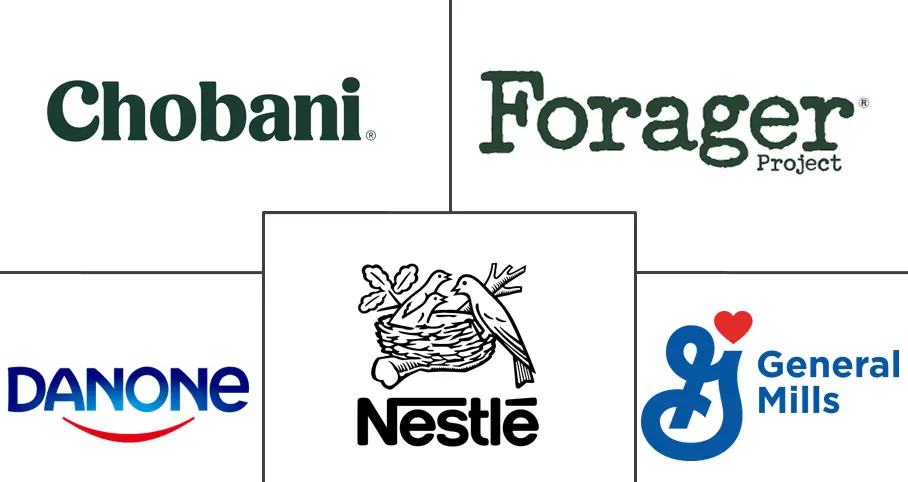Market Size of Fruit Yogurt Industry

| Study Period | 2019 - 2029 |
| Base Year For Estimation | 2023 |
| CAGR | 7.00 % |
| Fastest Growing Market | Asia Pacific |
| Largest Market | Europe |
| Market Concentration | Low |
Major Players
*Disclaimer: Major Players sorted in no particular order |
Fruit Yogurt Market Analysis
The fruit yogurt market is projected to grow at a CAGR of 7.0% during the forecast period (2020 - 2025).
- The demand for fruit yogurt is fueled by the availability of numerous flavors, and growing consumer indulgence for exotic flavors, coupled with significant investments by manufacturers. This prompts the manufacturers to develop products with innovative flavors to cater to the surging demand.
- Globally, with the growing trend of veganism has to the demand for non-dairy-based yogurt products, thus, the segment is anticipated to grow at a faster rate. Owing to the large retail space and convenient conventional services, supermarkets/ hypermarkets remain as one of the most preferred points of sale for fruit yogurt.
- The global fruit yogurt market is highly competitive with the presence of various global and regional players, including several private label brands. However, the major players operating in the market are Danone, General Mills, Chobani, and Nestle, among others.
Fruit Yogurt Industry Segmentation
The market is segmented into category, type and distribution. Fruit yogurt market by category, is segmented into dairy-based and dairy-free. By type the market is segmented into spoonable yogurt and drinkable yogurt. By distribution channel, the market is segmented into supermarkets/hypermarkets, convenience stores, specialty stores, online retail stores, and others.
Fruit Yogurt Market Size Summary
The fruit yogurt market is experiencing significant growth, driven by the increasing consumer preference for diverse and exotic flavors, alongside substantial investments from manufacturers in product innovation. The trend towards veganism has also boosted the demand for non-dairy yogurt products, which are expected to grow rapidly. Supermarkets and hypermarkets remain the preferred retail channels due to their extensive space and convenience. The market is highly competitive, with major players like Danone, General Mills, Chobani, and Nestle leading the charge, while also facing competition from various global and regional brands. The rising prevalence of digestive disorders has further fueled the demand for probiotic foods, with fruit yogurt being a popular choice in both spoonable and drinkable forms. This has prompted key players to invest in research and development to create innovative products with health claims, such as low sugar content, to meet evolving consumer preferences.
Europe holds a significant share of the fruit yogurt market, driven by a consumer shift towards innovative and healthy diets. The incorporation of fruits in yogurt provides both nutritional and flavor benefits, making it a popular choice in the region. Leading companies are heavily investing in product innovation to cater to European consumers, who are increasingly aware of sugar content in yogurt products. This has led to the introduction of products with no added sugar and natural ingredients, such as Arla's Arla Bio Nur and Danone's Oikos with new fruit fondues. The market's competitive landscape is characterized by major players like Danone and General Mills holding substantial shares, while Chobani and Nestle also maintain significant positions. To capture a larger market share, these companies are focusing on product development and introducing fruit yogurts with clinical claims, such as non-GMO and organic certifications, to attract health-conscious consumers globally.
Fruit Yogurt Market Size - Table of Contents
-
1. MARKET DYNAMICS
-
1.1 Market Drivers
-
1.2 Market Restraints
-
1.3 Porter's Five Forces Analysis
-
1.3.1 Threat of New Entrants
-
1.3.2 Bargaining Power of Buyers/Consumers
-
1.3.3 Bargaining Power of Suppliers
-
1.3.4 Threat of Substitute Products
-
1.3.5 Intensity of Competitive Rivalry
-
-
-
2. MARKET SEGMENTATION
-
2.1 By Category
-
2.1.1 Dairy-based
-
2.1.2 Dairy-free
-
-
2.2 By Type
-
2.2.1 Spoonable Yogurt
-
2.2.2 Drinkable Yogurt
-
-
2.3 By Distribution Channel
-
2.3.1 Supermarkets/Hypermarkets
-
2.3.2 Convenience Stores
-
2.3.3 Specialty Stores
-
2.3.4 Online Retail Stores
-
2.3.5 Others
-
-
2.4 Geography
-
2.4.1 North America
-
2.4.1.1 United States
-
2.4.1.2 Canada
-
2.4.1.3 Mexico
-
2.4.1.4 Rest of North America
-
-
2.4.2 Europe
-
2.4.2.1 Spain
-
2.4.2.2 United Kingdom
-
2.4.2.3 Germany
-
2.4.2.4 France
-
2.4.2.5 Italy
-
2.4.2.6 Russia
-
2.4.2.7 Rest of Europe
-
-
2.4.3 Asia Pacific
-
2.4.3.1 China
-
2.4.3.2 Japan
-
2.4.3.3 India
-
2.4.3.4 Australia
-
2.4.3.5 Rest of Asia-Pacific
-
-
2.4.4 South America
-
2.4.4.1 Brazil
-
2.4.4.2 Argentina
-
2.4.4.3 Rest of South America
-
-
2.4.5 Middle East and Africa
-
2.4.5.1 South Africa
-
2.4.5.2 Saudi Arabia
-
2.4.5.3 Rest of Middle East and Africa
-
-
-
Fruit Yogurt Market Size FAQs
What is the current Fruit Yogurt Market size?
The Fruit Yogurt Market is projected to register a CAGR of 7% during the forecast period (2024-2029)
Who are the key players in Fruit Yogurt Market?
Chobani Global Holdings, Inc., Nestlé S.A., General Mills Inc., Danone S.A. and Forager Project are the major companies operating in the Fruit Yogurt Market.

